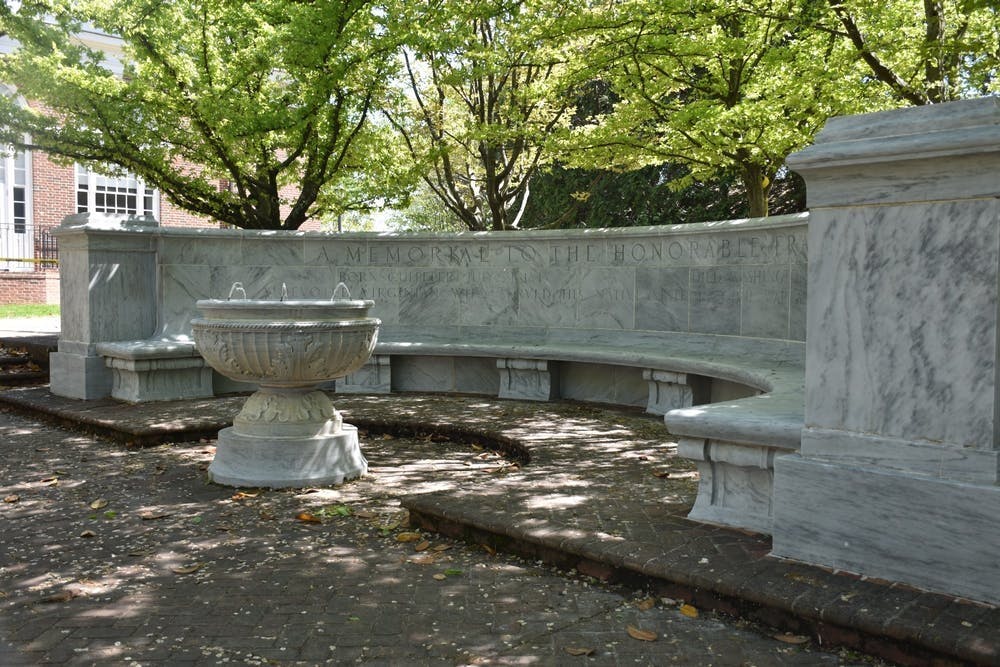Lea en español
The MRC pledged to continue pushing for the removal of the Frank Hume Memorial Wall — a Confederate monument also known as the Whispering Wall — in a statement released June 7. Rather than removing the wall entirely, the Board of Visitors approved a resolution June 4 to remove the inscription on the wall, which currently reads “a devoted Virginian who served his native state in Civil War and Legislative Hall,” and replace it with contrasting blocks.
The statement was signed by the Black Student Alliance, the Organization of African Students, the Asian Student Leadership Council, the Muslim Student Association, the Native American Student Union, undocUVA, Muslims United, Political Latinxs United for Movement and Action in Society at U.Va., the Latinx Student Alliance and the Queer Student Union, all organizations under the umbrella of the MRC.
The Frank Hume Memorial Wall, located near Monroe Hall and Newcomb Hall, is named for Hume, who was a soldier in the Confederate army during the Civil War and a delegate in the Virginia House of Delegates. His two sons, both of whom attended the University, donated much of the money to erect the memorial in 1938.
The Naming and Memorials Committee’s decision to replace the wall’s inscription with contrasting blocks was made after undergoing research, consultation and hearing community feedback, including at a public listening session held in April. According to the recommendation, rather than replacing the inscription with blocks of the same color, contrasting blocks will “mark the permanent change that has been made to [the] structure.”
“Our aim, then, in making this recommendation is neither to erase history nor to change it, but to enliven present and future generations ... to the circumstances under which a significant feature of the built environment on our Grounds was created and named,” the recommendation said.
The MRC’s statement calls for the Board to reverse its decision to keep the wall, saying that keeping the original structure shows the University’s lack of commitment to its Black students. Maintaining the memorial’s current place showcases the same values of white supremacy that the MRC said that the University still holds today while removing the structure of the wall would be a step in reckoning with that past and supporting Black people at the University.
“On the same grounds that the University aims to honor the legacy of enslaved people, they maintain a memorial to a person who fought on the side of upholding the very institution that enslaved them,” the MRC said in its statement, referencing the Memorial to Enslaved Laborers, which was completed in spring 2020 and dedicated in April 2021.
Abena Appiah-Ofori, chair of the MRC and rising third-year College student, independently started a petition last June with her friend Chloe Leon, rising third-year College student, to remove the wall. MRC took up the issue, launching a letter-writing campaign and a petition in February. The petition called for the removal of the wall as a sign that the University “will no longer value white supremacist history over its Black students.”
During its meeting, the Board also decided to refer to the wall as the Whispering Wall, removing references to Hume. The wall has been called the Whispering Wall due to its unique ability to transmit sound from one side of the wall to the other.
These decisions were in line with a proposal made by the Naming and Memorials Committee, which was established in February to make suggestions for recontextualizing and renaming buildings and memorials on Grounds. In April, the Board voted to support a digital contextualization of the University’s statues and memorials based on the committee’s recommendations. The Naming and Memorials Committee concluded that a digital contextualization of the statues and memorials would help students, visitors and community members develop an “informed perspective.” Some suggested digital methods include placing QR codes near statues and memorials.
While the Board stated that it hoped recontextualization of the wall would “promote nuanced and complex historical understandings,” MRC states that this is not enough.
“Removing the Whispering Wall’s inscription while allowing its structure, which has been erected for nearly a century, to stand is not enough of an adjustment to denounce a treacherous history of violence and exploitation advocated for by the Confederacy,” the MRC’s statement said.
The committee held a listening session in April regarding the fate of the wall, where over a dozen community members expressed their support for the wall’s removal. MRC is continuing to push for its removal, asserting in its statement that “the structure will always serve as a reminder that the racist, white supremacist ideals upheld by the Confederacy are also ideals the University is proud to preserve.”
Several MRC members — including Maya Tietz, chief publicity officer of the MRC and rising second-year College student, and Amanda Campbell, MRC vice chair of advocacy and rising third-year College student, and Tichara Robertson, MRC vice chair of advocacy and rising second-year College student — sent emails to University President Jim Ryan and BOV Rector James Murray asking them to reverse their decision to keep the memorial. They also noted how the Charlottesville City Council had unanimously decided to remove Charlottesville’s Robert E. Lee and Stonewall Jackson statues and asked that the University follow Charlottesville’s lead.
Murray wrote to Robertson saying that the Board made a thoughtful recommendation after engaging in a comprehensive process of gathering views, including those from the MRC.







